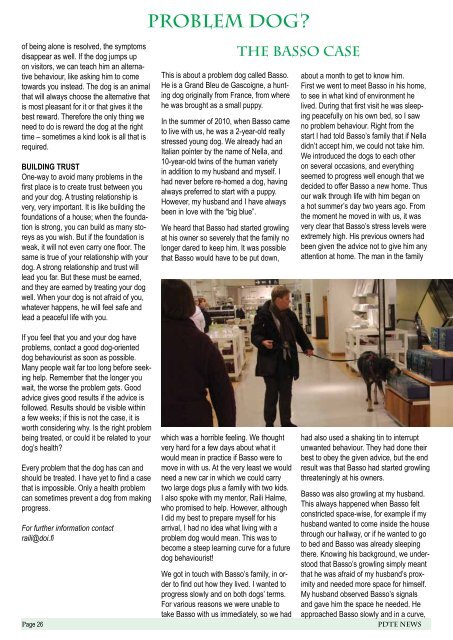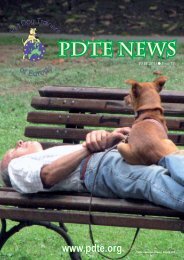PDTE 2012 October Newsletter
You also want an ePaper? Increase the reach of your titles
YUMPU automatically turns print PDFs into web optimized ePapers that Google loves.
Problem dog?<br />
of being alone is resolved, the symptoms<br />
disappear as well. If the dog jumps up<br />
on visitors, we can teach him an alternative<br />
behaviour, like asking him to come<br />
towards you instead. The dog is an animal<br />
that will always choose the alternative that<br />
is most pleasant for it or that gives it the<br />
best reward. Therefore the only thing we<br />
need to do is reward the dog at the right<br />
time – sometimes a kind look is all that is<br />
required.<br />
Building trust<br />
One-way to avoid many problems in the<br />
first place is to create trust between you<br />
and your dog. A trusting relationship is<br />
very, very important. It is like building the<br />
foundations of a house; when the foundation<br />
is strong, you can build as many storeys<br />
as you wish. But if the foundation is<br />
weak, it will not even carry one floor. The<br />
same is true of your relationship with your<br />
dog. A strong relationship and trust will<br />
lead you far. But these must be earned,<br />
and they are earned by treating your dog<br />
well. When your dog is not afraid of you,<br />
whatever happens, he will feel safe and<br />
lead a peaceful life with you.<br />
This is about a problem dog called Basso.<br />
He is a Grand Bleu de Gascoigne, a hunting<br />
dog originally from France, from where<br />
he was brought as a small puppy.<br />
In the summer of 2010, when Basso came<br />
to live with us, he was a 2-year-old really<br />
stressed young dog. We already had an<br />
Italian pointer by the name of Nella, and<br />
10-year-old twins of the human variety<br />
in addition to my husband and myself. I<br />
had never before re-homed a dog, having<br />
always preferred to start with a puppy.<br />
However, my husband and I have always<br />
been in love with the “big blue”.<br />
We heard that Basso had started growling<br />
at his owner so severely that the family no<br />
longer dared to keep him. It was possible<br />
that Basso would have to be put down,<br />
THE BASSO CASE<br />
about a month to get to know him.<br />
First we went to meet Basso in his home,<br />
to see in what kind of environment he<br />
lived. During that first visit he was sleeping<br />
peacefully on his own bed, so I saw<br />
no problem behaviour. Right from the<br />
start I had told Basso’s family that if Nella<br />
didn’t accept him, we could not take him.<br />
We introduced the dogs to each other<br />
on several occasions, and everything<br />
seemed to progress well enough that we<br />
decided to offer Basso a new home. Thus<br />
our walk through life with him began on<br />
a hot summer’s day two years ago. From<br />
the moment he moved in with us, it was<br />
very clear that Basso’s stress levels were<br />
extremely high. His previous owners had<br />
been given the advice not to give him any<br />
attention at home. The man in the family<br />
If you feel that you and your dog have<br />
problems, contact a good dog-oriented<br />
dog behaviourist as soon as possible.<br />
Many people wait far too long before seeking<br />
help. Remember that the longer you<br />
wait, the worse the problem gets. Good<br />
advice gives good results if the advice is<br />
followed. Results should be visible within<br />
a few weeks; if this is not the case, it is<br />
worth considering why. Is the right problem<br />
being treated, or could it be related to your<br />
dog’s health?<br />
Every problem that the dog has can and<br />
should be treated. I have yet to find a case<br />
that is impossible. Only a health problem<br />
can sometimes prevent a dog from making<br />
progress.<br />
For further information contact<br />
raili@doi.fi<br />
Page 26<br />
which was a horrible feeling. We thought<br />
very hard for a few days about what it<br />
would mean in practice if Basso were to<br />
move in with us. At the very least we would<br />
need a new car in which we could carry<br />
two large dogs plus a family with two kids.<br />
I also spoke with my mentor, Raili Halme,<br />
who promised to help. However, although<br />
I did my best to prepare myself for his<br />
arrival, I had no idea what living with a<br />
problem dog would mean. This was to<br />
become a steep learning curve for a future<br />
dog behaviourist!<br />
We got in touch with Basso’s family, in order<br />
to find out how they lived. I wanted to<br />
progress slowly and on both dogs’ terms.<br />
For various reasons we were unable to<br />
take Basso with us immediately, so we had<br />
had also used a shaking tin to interrupt<br />
unwanted behaviour. They had done their<br />
best to obey the given advice, but the end<br />
result was that Basso had started growling<br />
threateningly at his owners.<br />
Basso was also growling at my husband.<br />
This always happened when Basso felt<br />
constricted space-wise, for example if my<br />
husband wanted to come inside the house<br />
through our hallway, or if he wanted to go<br />
to bed and Basso was already sleeping<br />
there. Knowing his background, we understood<br />
that Basso’s growling simply meant<br />
that he was afraid of my husband’s proximity<br />
and needed more space for himself.<br />
My husband observed Basso’s signals<br />
and gave him the space he needed. He<br />
approached Basso slowly and in a curve,<br />
<strong>PDTE</strong> NEWS

















